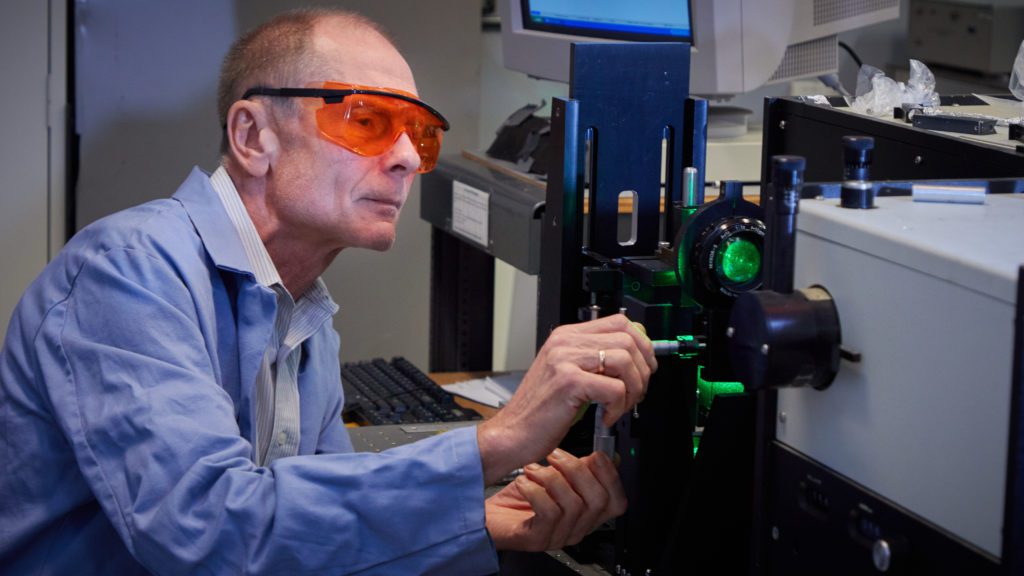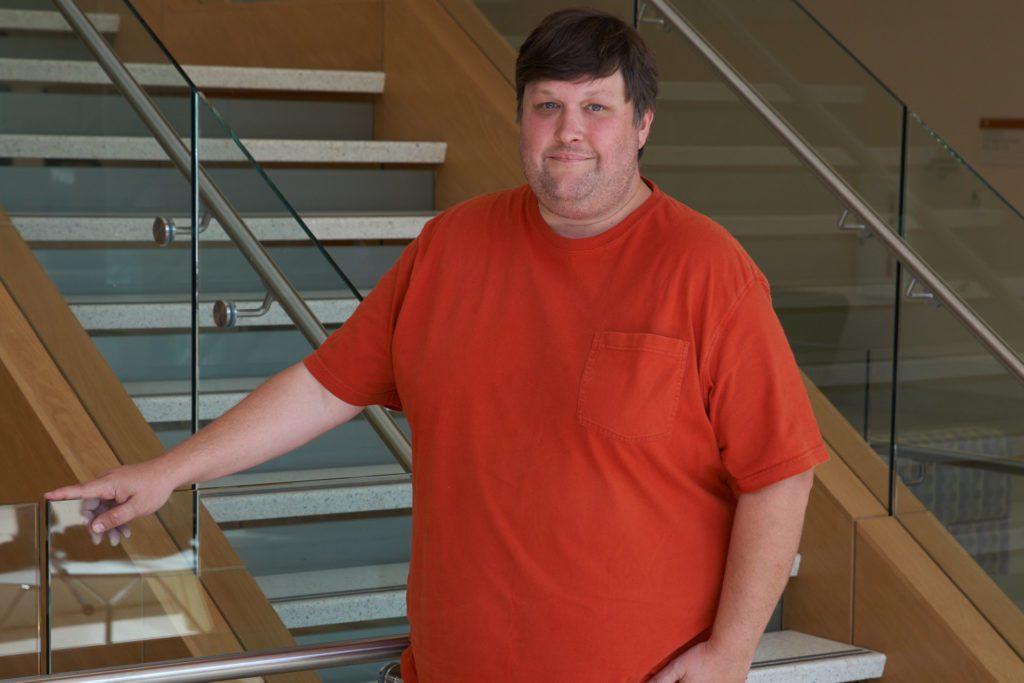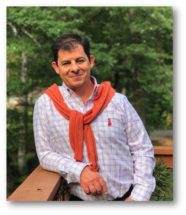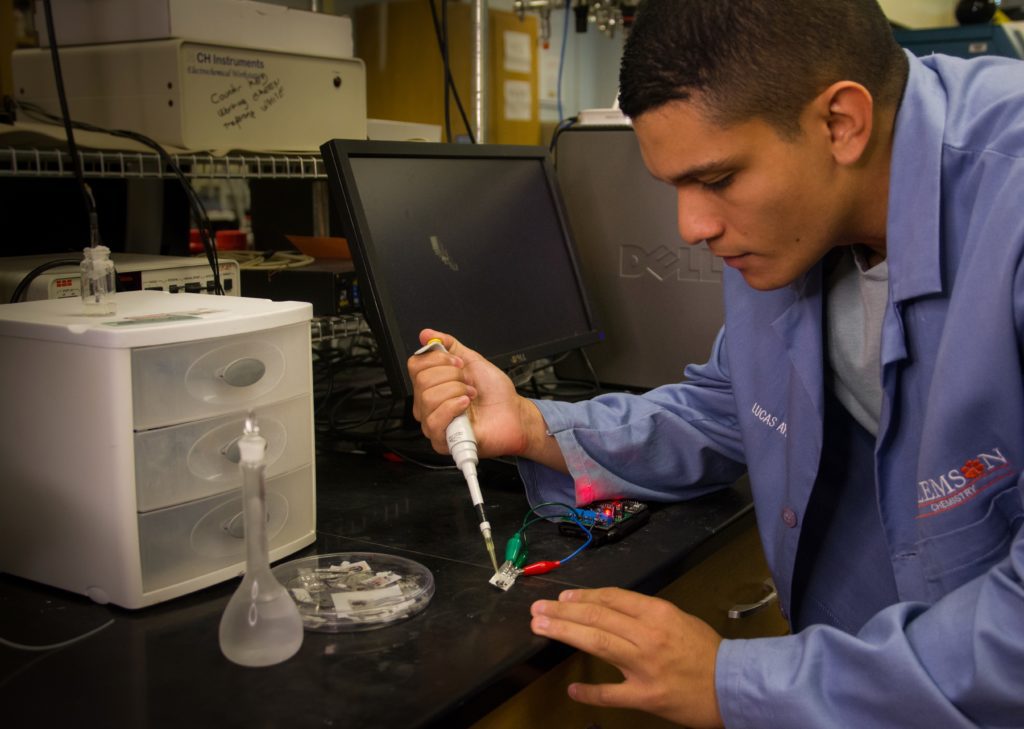10.17.22
Chemistry touches every aspect of everyday life, from the air we breathe and the food we eat to the cars we drive and the products we use.
This week is National Chemistry Week, an event sponsored by the American Chemical Society to highlight chemistry’s importance.
This year’s theme is “Fabulous Fibers: The Chemistry of Fabrics.” To celebrate, the Clemson University College of Science is spotlighting three faculty members whose research is linked to the use of various fibers.
Disappearing colors

Chemistry Professor George Chumanov helped an automotive upholstery manufacturer determine why their fabric started to fade when the car was parked in the sun on dealer lots.
Clemson Chemistry Professor George Chumanov and his colleagues turned into a detectives of sorts when an automobile upholstery manufacturing company asked for help. The cars’ seat fabric was suddenly starting to fade when the sun hit the cars parked on dealer lots.
“It’s all chemistry,” Chumanov said. “What happens when fabric fades is that the dye molecules decompose. The molecules fall apart, and the color disappears. Photobleaching happens every minute. You cannot prevent it. The question is how to minimize and control it.”
One of Chumanov’s areas of expertise is “photophysics” — the physics of light and its interaction with matter.
“It was immediately apparent to us that the problem had something to do with the manufacturing process, that they had inevitably changed something that ultimately led to the fabric being less stable,” he said.
Knowing the fundamentals of photodegradation is just the first step. “Translating those fundamentals into the real why is much more complex,” said Chumanov.
Besides sunlight, factors such as oxygen levels, moisture and temperature can affect the fabric and dye molecules.
Here, Chumanov’s lab, Department of Chemistry lecturer Rakesh Sachdeva and specialists from the manufacturing company used a variety of tools — including chemical, optical and mass spectrometry measurements — to reveal how properties of the dyes and fabrics had changed before and after the fading to pinpoint causes of the problem.
“I learned how to appreciate the complexity of real-world situations. It’s often extremely difficult to identify the problem under conditions where you don’t have full control of conditions,” said Chumanov, whose fabric research has also included creating clothing that repelled dirt and making yarns that can produce electricity when exposed to sunlight.
His current research involves the synthesis and investigation of high-end carbon nanofibers.
Removing pollutants

Daniel Whitehead, an associate professor in the Department of Chemistry, has turned cotton fibers into nanoparticles that remove environmental pollutants.
Thanks to its practicality, comfort and convenience, cotton is the most popular fabric in the world. But Daniel Whitehead, an associate professor in the Department of Chemistry, isn’t using it to make blue jeans or T-shirts. Instead, he is turning cotton fibers into nanoparticles that remove environmental pollutants.
Cotton is about 80 percent cellulose. Whitehead’s lab degrades the non-crystalline portion of the cotton fibers using a chemical reaction, leaving tiny cellulose nanocrystals. Between 1,000 and 1,600 of the nanocrystals would fit on the cross-section surface of a human hair.
A polymer placed on the surface of the nanocrystals reacts with the target contaminant.
Initially, the project targeted volatile compounds that caused odors during the fat-rendering process that separates protein from fat in leftover parts of animals we don’t eat for use in pet food. Researchers made a filter cartridge out of the nanoparticles and passed the air from the plant through the filter. They found the filter removed at least 95 percent of the odor molecules from the air.
Whitehead’s lab has also used the nanoparticles to degrade pesticides and remove polyfluorinated surfactants, a persistent environmental contaminant, from water. Scientists have also investigated using nanocrystals to remove metal contaminants from rendered fat so it can be refined into renewable fuel.
“What we like about cellulose nanocrystals is that they’re very cheap to make because they come from cotton, which is a commodity crop. They’re easy to chemically modify after we’ve synthesized them, and it gives us a nice biodegradable platform that we can use for these applications to remove contaminants from the environment,” Whitehead said. “We think it’s useful for a variety of applications.”
While the lab has showed that the material works in multiple applications at a lab scale, it must still prove it can work on an industrial scale for an affordable price.
“We’ve shown we can do this with 100 milliliters of fat. What happens if we try to do it with 1,000 pounds of fat? The question is, can we make it affordable enough that it can be applied in the market?” he said.
Wearable devices
When most people think of wearable devices, they probably think of smartwatches, fitness trackers and wearable monitors that collect information on physical activity, measure blood oxygen saturation levels, detect falls and even surveil heart rhythms.
Clemson Chemistry Professor Carlos Garcia’s lab is researching a different type of a wearable device that would use paper fibers (turned into carbon electrodes) to efficiently and inexpensively detect infections or even monitor cancer biomarkers to determine whether a treatment is working.

Carlos Garcia

Lucas Ayres, a graduate student in Chemistry Professor Carlos Garcia’s lab, helped solve two challenges in using carbon electrodes made from paper fibers in wearable devices that would detect infections.
Clemson Chemistry Professor Carlos Garcia’s lab is researching a different type of a wearable device that would use paper fibers (turned into carbon electrodes) to efficiently and inexpensively detect infections or even monitor cancer biomarkers to determine whether a treatment is working.
Wearable devices could give doctors the information they need to treat a problem.
“Most often, doctors make a diagnosis based on the best clinical data available,” Garcia said. “We want to provide more data so that diagnosis is more accurate and ultimately improve clinical outcomes.”
Using pyrolysis, the paper is heated in the absence of oxygen to temperatures high enough that the cellulose fibers turn to carbon while preserving the paper’s 3D structure.
“You end up with something that looks like spaghetti noodles, and each of the fibers can conduct electricity and become a chemical sensor,” Garcia said. “That gives us tremendous flexibility in the design of these sensors and allows us to measure things we could not measure with standard color-based devices.”
Previously, Garcia’s lab created sensors that measured metabolites, gases, heavy metals and even bleach.
However, two factors limited the applicability of this material in wearable applications — brittleness and some electrical resistance. But Lucas Ayres, a Ph.D. student in Garcia’s lab, used a natural polymer to coat the electrodes, making them flexible enough to withstand bending and added a thin layer of gold to improve the electron transfer process. In collaboration with Kristi Whitehead, a senior lecturer in the Department of Biological Sciences, they developed a device that can be attached to skin and detect the presence of Staphylococcus aureus, a commonly misdiagnosed and mistreated pathogen.
“Fundamentally, Lucas is addressing limitations that apply to many other carbon materials, enabling the development of other sensors. On the application side, this addresses a clinical need to have a way of diagnosing these infections using a system that is not invasive and inexpensive,” Garcia said.
See the full article here.
five-ways-keep-your-child-safe-school-shootings
Please help promote STEM in your local schools.
Ranked as the 27th best national public university by U.S. News & World Report, Clemson University is dedicated to teaching, research and service. Founded in 1889, we remain committed both to world-class research and a high quality of life. In fact, 92 percent of our seniors say they’d pick Clemson again if they had it to do over.
Clemson’s retention and graduation rates rank among the highest in the country for public universities. We’ve been named among the “Best Public College Values” by Kiplinger Magazine in 2019, and The Princeton Review named us among the “Best Value Colleges” for 2020.
Our beautiful college campus sits on 20,000 acres in the foothills of the Blue Ridge Mountains, along the shores of Lake Hartwell. And we also have research facilities and economic development hubs throughout the state of South Carolina — in Anderson, Blackville, Charleston, Columbia, Darlington, Georgetown, Greenville, Greenwood, and Pendleton.
The research, outreach and entrepreneurial projects led by our faculty and students are driving economic development and improving quality of life in South Carolina and beyond. In fact, a recent study determined that Clemson has an annual $1.9 billion economic impact on the state.
Just as founder Thomas Green Clemson intertwined his life with the state’s economic and educational development, the Clemson Family impacts lives daily with their teaching, research and service.
How Clemson got its start
University founders Thomas Green and Anna Calhoun Clemson had a lifelong interest in education, agricultural affairs and science.
In the post-Civil War days of 1865, Thomas Clemson looked upon a South that lay in economic ruin, once remarking, “This country is in wretched condition, no money and nothing to sell. Everyone is ruined, and those that can are leaving.”
Thomas Clemson’s death on April 6, 1888, set in motion a series of events that marked the start of a new era in higher education in South Carolina. In his will, he bequeathed the Fort Hill plantation and a considerable sum from his personal assets for the establishment of an educational institution that would teach scientific agriculture and the mechanical arts to South Carolina’s young people.
Clemson Agricultural College formally opened as an all-male military school in July 1893 with an enrollment of 446. It remained this way until 1955 when the change was made to “civilian” status for students, and Clemson became a coeducational institution. In 1964, the college was renamed Clemson University as the state legislature formally recognized the school’s expanded academic offerings and research pursuits.
More than a century after its opening, the University provides diverse learning, research facilities and educational opportunities not only for the people of the state — as Thomas Clemson dreamed — but for thousands of young men and women throughout the country and the world.


